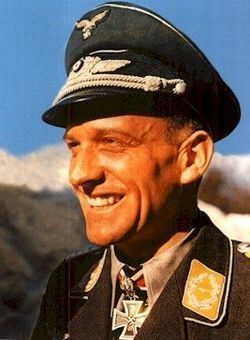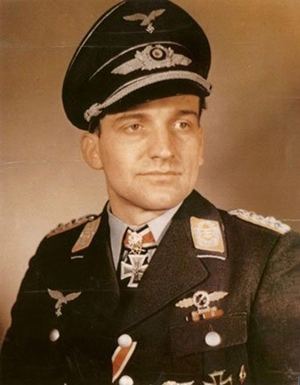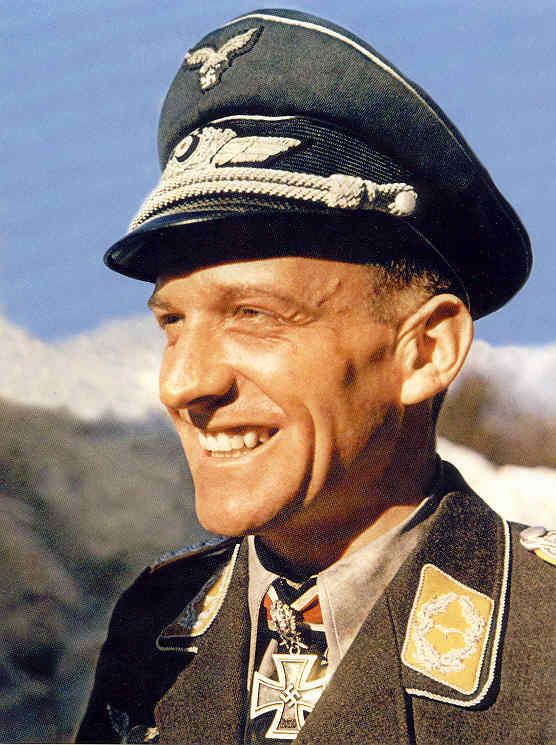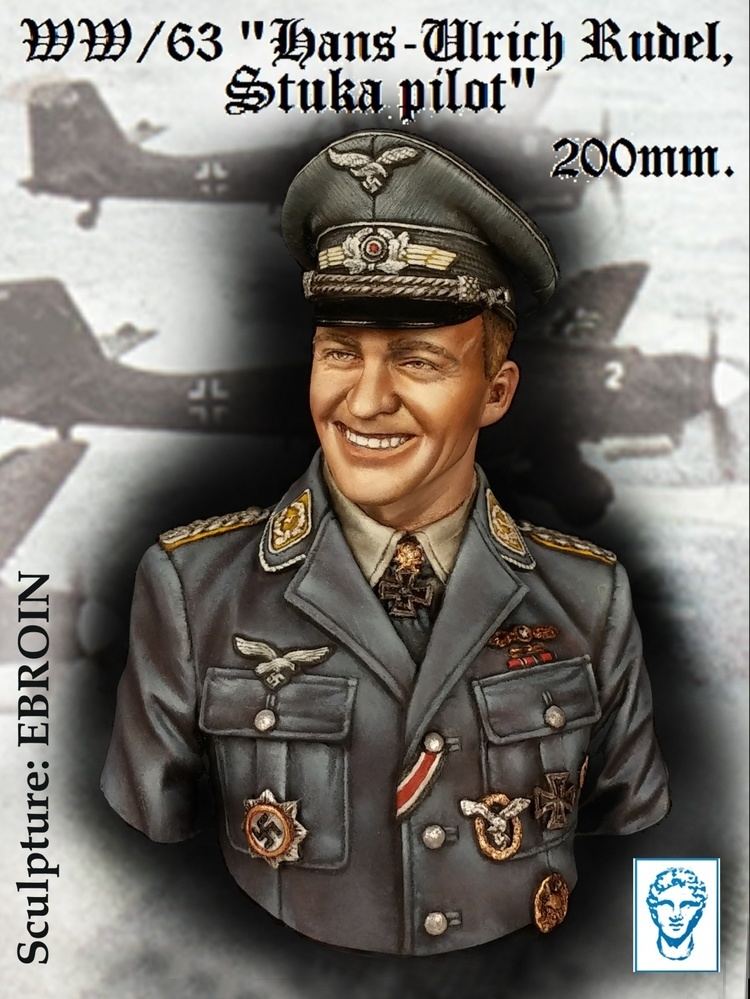Name Hans-Ulrich Rudel Role Military Officer | Years of service 1936–45 Books Stuka Pilot | |
 | ||
Parents Johannes Rudel, Martha Rudel Similar People Erich Hartmann, Simo Hayha, Hiroshi Funasaka | ||
Place of burial Theilenhofen, Germany | ||
Ace german air force stuka dive bomber pilot hans ulrich rudel in a garden with a hd stock footage
Hans-Ulrich Rudel (2 July 1916 – 18 December 1982) was a German ground-attack pilot during World War II. Post-war, he was a prominent neo-Nazi activist in Latin America and West Germany.
Contents
- Ace german air force stuka dive bomber pilot hans ulrich rudel in a garden with a hd stock footage
- Luftchat with Bismarck Ground Attack Hans Ulrich Rudel Psychological Effects
- Early life
- World War II
- Nazi activist
- In South America
- Public scandals
- Personal life death and funeral
- Summary of military career
- References

During the war, Rudel was credited with the destruction of 519 tanks, as well as a number of ships. He claimed 9 aerial victories and the destruction of more than 800 vehicles of all types. He flew 2,530 ground-attack missions exclusively on the Eastern Front, usually flying the Junkers Ju 87 "Stuka" dive bomber, and 430 missions flying fighter aircraft. Rudel was the most decorated German serviceman of World War II receiving the Knight's Cross of the Iron Cross with Golden Oak Leaves, Swords, and Diamonds in January 1945; the decoration was created specifically for him. Rudel surrendered to US forces on 8 May 1945.

Rudel fled to Argentina in 1948. A committed and unrepentant Nazi, he founded the "Kameradenwerk", a relief organization for Nazi criminals that helped fugitives escape to Latin America and the Middle East. Together with Willem Sassen, Rudel helped shelter Josef Mengele, the notorious former SS doctor at Auschwitz. He worked as an arms dealer and a military advisor to the regimes of Juan Perón in Argentina, of Augusto Pinochet in Chile, and of Alfredo Stroessner in Paraguay. Due to these activities, he was placed under observation by the US Central Intelligence Agency.

In the West German federal election of 1953, Rudel, who had returned to West Germany, was the top candidate for the far-right German Reich Party but was not elected to the Bundestag. Following the Revolución Libertadora in 1955, the uprising that ended the second presidential term of Perón, Rudel moved to Paraguay, where he acted as a foreign representative for several German companies. In 1977, he became a spokesman for the German People's Union, a neo-Nazi political party founded by the extremist politician Gerhard Frey. Rudel died in West Germany in 1982.

[Luftchat with Bismarck] Ground Attack: Hans Ulrich Rudel & Psychological Effects
Early life

Rudel was born on 2 July 1916 in Konradswaldau, in Prussia. He was the third child of Lutheran minister Johannes Rudel. As a boy, Rudel was a poor scholar, but a very keen sportsman. Rudel attended the humanities oriented Gymnasium, in Lauban. He joined the Hitler Youth in 1933. After graduating with Abitur in 1936, he participated in the compulsory Reich Labour Service (RAD). Following the labour service, Rudel joined the Luftwaffe where he began his military career as an air reconnaissance pilot.
World War II

German forces invaded Poland in 1939 starting World War II in Europe. As an air observer, Rudel flew on long-range reconnaissance missions over Poland. During 1940, he served as a regimental adjutant for the 43rd Aviators Training Regiment, based at Vienna.

In early 1941, he underwent training as a Stuka pilot. He was posted to a dive-bomber wing, Sturzkampfgeschwader 2 (StG 2), which was moved to occupied Poland in preparation for Operation Barbarossa, the invasion of the Soviet Union, in June 1941. On 21 September 1941, Rudel took part in an attack on the Soviet battleship Marat of the Baltic Fleet. Marat' was sunk at her moorings on 23 September 1941 by two near-simultaneous hits by 1,000-kilogram (2,200 lb) bombs near the forward superstructure. They caused the explosion of the forward magazine which demolished the superstructure and the forward part of the hull. 326 men were killed and the ship gradually settled to the bottom in 11 meters (36 ft) of water. Her sinking is commonly credited to Rudel, but he dropped only one of the two bombs. Rudel's unit then took part in Operation Typhoon, Army Group Center's attempt to capture the Soviet capital.

Rudel's gunner from October 1941 was Erwin Hentschel, who served with Rudel for the next two and a half years, earning the Knight's Cross of the Iron Cross during that period. He completed 1400 sorties with Rudel and drowned on 21 March 1944 when they were making their way to the German lines following a forced landing.

In early 1942, Rudel got married while home on leave. Later in the year, he took part in the Battle of Stalingrad. In February 1943, Rudel flew his 1,000th combat mission. He then participated in the experiments with using the Ju 87 G in the anti-tank role. The anti-tank unit took part in operations against the Soviet Kerch–Eltigen Operation. The footage from an onboard gun camera was used in Die Deutsche Wochenschau, a Reich Ministry of Propaganda newsreel. In April 1943, Rudel was awarded the Oak Leaves to the Knight's Cross, receiving them from Hitler personally in Berlin. Rudel participated in the Battle of Kursk with the same unit. In October 1943, Rudel was credited with the destruction of his 100th tank and was awarded the Knight's Cross of the Iron Cross with Oak Leaves and Swords on 25 November.
Rudel was appointed Gruppenkommandeur of III. Gruppe on 22 February 1944. On 20 March, Rudel performed a forced landing behind Soviet line and he and his gunner set out to the German lines on foot. The men attempted to swim across the Dniester River and Rudel's gunner drowned in the attempt. Upon his return, Ernst Gadermann, previously the troop doctor of III. Gruppe, joined Rudel as his new radio operator and air gunner. Rudel was awarded the Knight's Cross of the Iron Cross with Oak Leaves, Swords and Diamonds on 29 March 1944, the tenth member of the Wehrmacht to receive this award. The presentation was made by Hitler personally.
Rudel was promoted to Oberstleutnant on 1 September 1944, and appointed leader of SG 2, replacing Stepp, on 1 October 1944. On 22 December 1944, Rudel completed his 2,400th combat mission, and the next day, he reported his 463rd tank destroyed. On 29 December 1944, Rudel was promoted to Oberst (colonel), and was awarded the Knight's Cross of the Iron Cross with Golden Oak Leaves, Swords, and Diamonds, the only person to receive this decoration. This award was presented to him by Hitler on 1 January 1945.
On 8 February 1945, Rudel was badly wounded in the right foot, and crash landed inside German lines. Rudel's leg was amputated below the knee. He returned to flying on 25 March 1945. He claimed 26 more tanks destroyed by the end of the war. On 19 April 1945, the day before Hitler's final birthday, Rudel met with Hitler in the Führerbunker at the Reich Chancellery in Berlin. On 8 May 1945, Rudel fled westward from an airfield near Prague, landing in US controlled territory, and surrendered.
Nazi activist
Rudel was released In April 1946. While Rudel was interned, his family fleeing from the advancing Red Army had found refuge with Gadermann's parents in Wuppertal. Rudel went into private business. In 1948, he emigrated to Argentina via the ratlines, travelling via the Austrian Zillertal to Italy. In Rome, with the help of South Tyrolean smugglers, and aided by the Austrian bishop Alois Hudal, he bought himself a fake Red Cross passport with the cover name "Emilio Meier", and took a flight from Rome to Buenos Aires, where he arrived on 8 June 1948.
In South America
After Rudel moved to Argentina, he became a close friend and confidant of the President of Argentina Juan Perón, and Paraguay's dictator Alfredo Stroessner. In Argentina, he founded the "Kameradenwerk" (lit. "comrades work" or "comrades act"), a relief organization for Nazi war criminals. Prominent members of the "Kameradenwerk" included SS officer Ludwig Lienhardt, whose extradition from Sweden had been demanded by the Soviet Union on war crime charges, Kurt Christmann, a member of the Gestapo sentenced to 10 years for war crimes committed at Krasnodar, Austrian war criminal Fridolin Guth, and the German spy in Chile, August Siebrecht. The group maintained close contact with other internationally wanted fascists, such as Ante Pavelić, Carlo Scorza and Konstantin von Neurath. In addition to these war criminals that fled to Argentina, the "Kameradenwerk" also assisted Nazi criminals imprisoned in Europe, including Rudolf Hess and Karl Dönitz, with food parcels from Argentina and sometimes by paying their legal fees. In Argentina, Rudel became acquainted with notorious Nazi concentration camp doctor and war criminal Josef Mengele. Rudel, together with Willem Sassen, a former Waffen-SS and war correspondent for the Wehrmacht, who initially worked as Rudel's driver, helped to relocate Mengele to Brazil by introducing him to Nazi supporter Wolfgang Gerhard. In 1957, Rudel and Mengele together travelled to Chile to meet with Walter Rauff, the inventor of the mobile gas chamber.
In Argentina, Rudel lived in Villa Carlos Paz, roughly 36 kilometers (22 mi) from the populous Córdoba City, where he rented a house and operated a brickworks. There, Rudel wrote his wartime memoirs Trotzdem ("Nevertheless" or "In Spite of Everything"). The book was published in November 1949 by the Dürer-Verlag in Buenos Aires. Dürer-Verlag (1947–1958) issued a variety of apologia by former Nazis and their collaborators. Besides Rudel, among the early editors are Wilfred von Oven, the personal Press adjutant of Goebbels, and Naumann. Sassen convinced Adolf Eichmann to share his view on the Holocaust. Together with Eberhard Fritsch, a former Hitler Youth leader, Sassen began interviewing Eichmann in 1956 with the intent of publishing his views. The Dürer-Verlag went bankrupt in 1958.
Discussion ensued in Germany on Rudel being allowed to publish the book, because he was a known Nazi. In the book, he supported Nazi policies. This book was later re-edited and published in the United States, as the Cold War intensified, under the title, Stuka Pilot, which supported the German invasion of the Soviet Union. Pierre Clostermann, a French fighter pilot, had befriended Rudel and wrote the foreword to the French edition of his book Stuka Pilot. In 1951, he published a pamphlet Dolchstoß oder Legende? ("Stab in the Back or Legend?"), in which he claimed that "Germany's war against the Soviet Union was a defensive war", moreover, "a crusade for the whole world". In the 1950s, Rudel befriended Savitri Devi, a writer and proponent of Hinduism and Nazism, and introduced her to a number of Nazi fugitives in Spain and the Middle East.
With the help of Perón, Rudel secured lucrative contracts with the Brazilian military. He was also active as a military adviser and arms dealer for the Bolivian regime, Augusto Pinochet in Chile and Stroessner in Paraguay. He was in contact with Werner Naumann, formerly a State Secretary in Goebbels' Ministry of Public Enlightenment and Propaganda in Nazi Germany. Following the Revolución Libertadora in 1955, a military and civilian uprising that ended the second presidential term of Perón, Rudel was forced to leave Argentina and move to Paraguay. During the following years in South America, Rudel frequently acted as a foreign representative for several German companies, including Salzgitter AG, Dornier Flugzeugwerke, Focke-Wulf, Messerschmitt, Siemens and Lahmeyer International, a German consulting engineering firm. Rudel's input was used during the development of the A-10 Thunderbolt II, a United States Air Force aircraft designed solely for close air support, including attacking ground targets as tanks and armored vehicles.
According to the historian Peter Hammerschmidt, based on files of the German Federal Intelligence Service and the US Central Intelligence Agency (CIA), the BND, under the cover-up company "Merex", was in close contact with former SS and Nazi Party members. In 1966, Merex, represented by Walter Drück, a former Generalmajor in the Wehrmacht and BND agent, helped by the contacts established by Rudel and Sassen, sold discarded equipment of the Bundeswehr (German Federal armed forces) to various dictators in Latin America. According to Hammerschmidt, Rudel assisted in establishing contact between Merex and Friedrich Schwend, a former member of the Reich Main Security Office and involved in Operation Bernhard. Schwend, according to Hammerschmidt, had close links with the military services of Peru and Bolivia. In the early sixties, Rudel, Schwend and Klaus Barbie, founded a company called "La Estrella", the star, which employed a number of former SS officers who had fled to Latin America. Rudel, through La Estrella, was also in contact with Otto Skorzeny, who had his own network of former SS and Wehrmacht officers.
Rudel returned to West Germany in 1953 and became a leading member of the Neo-Nazi nationalist political party, the German Reich Party (Deutsche Reichspartei or DRP). In the West German federal election of 1953, Rudel was the top candidate for the DRP, but was not elected to the Bundestag. According to Josef Müller-Marein, editor-in-chief of Die Zeit, Rudel had an egocentric character. In his political speeches, Rudel made generalizing statements, claiming that he was speaking on behalf of most, if not all, former German soldiers of World War II. Rudel heavily criticized the Western Allies during World War II for not having supported Germany in its war against the Soviet Union. Rudel's political demeanor subsequently alienated him from his former comrades, foremost Gadermann. Müller-Marein concluded his article with the statement: "Rudel no longer has a Geschwader!" In 1977, he became a spokesman for the German People's Union, a nationalist political party founded by Gerhard Frey.
Public scandals
In October 1976, Rudel inadvertently triggered a chain of events, which were later dubbed the Rudel-Affäre (Rudel Scandal). Aufklärungsgeschwader 51 (51st Reconnaissance Wing) the latest unit to hold the name "Immelmann", held a reunion for members of the unit including those from World War II. The Secretary of State in the Federal Ministry of Defence, Hermann Schmidt authorized the event. Fearing that Rudel would spread Nazi propaganda on the German Air Force airbase in Bremgarten near Freiburg, Schmidt ordered that the meeting could not be held at the airbase. News of this decision reached Generalleutnant Walter Krupinski, at the time commanding general of NATO's Second Allied Tactical Air Force, and a former World War II fighter pilot. Krupinski contacted Gerhard Limberg, Inspector of the Air Force, requesting that the meeting be allowed to be held at the airbase. Limberg later confirmed Krupinski's request, and the meeting was held on Bundeswehr premises, a decision which Schmidt still did not agree to. Rudel attended the meeting, where besides signing his book and a few autographs, he refrained from making any political statements.
During a routine press event, journalists, who had been briefed by Schmidt, questioned Krupinski and his deputy Karl Heinz Franke about Rudel. In this interview, the generals compared Rudel's past as a Nazi and Neo-Nazi supporter to the career of prominent Social Democrat leader Herbert Wehner, who had been a member of the German Communist Party in the 1930s, and who had lived in Moscow during World War II, where he was allegedly involved in NKVD operations. Calling Wehner an extremist, they described Rudel as an honorable man, who "hadn't stolen the family silver or anything else". When these remarks became public, the Federal Minister of Defense Georg Leber, complying with §50 of the Soldatengesetz (Military law), ordered the generals into early retirement as of 1 November 1976. Leber, however, a member of the Social Democratic Party of Germany (SPD), was heavily criticized for his actions by the Christian Democratic Union (CDU) opposition, and the scandal contributed to the minister's retirement in early 1978. On 3 February 1977, the German Bundestag debated the scandal and its consequences. The Rudel Scandal subsequently triggered a military-tradition discussion, which the Federal Minister of Defense Hans Apel ended with the introduction of "Guidelines for Understanding and Cultivating Tradition" on 20 September 1982.
During the 1978 FIFA World Cup, held in Argentina, Rudel visited the German national football team in their training camp in Ascochinga. The German media criticized the German Football Association, and viewed Rudel's visit as being sympathetic to the military dictatorship that ruled Argentina following the 1976 Argentine coup d'état. During the 1958 FIFA World Cup in Sweden, he visited the German team at Malmö on 8 June 1958. There he was welcomed by team manager Sepp Herberger.
Personal life, death and funeral
Rudel was married three times. His 1942 marriage to Ursula, nicknamed "Hanne", produced two sons, Hans-Ulrich and Siegfried. They divorced in 1950. According to the news magazine Der Spiegel, one reason for the divorce was that his wife had sold some of his decorations, including the Oak Leaves with Diamonds, to an American collector, but she also refused to move to Argentina. On 27 March 1951, Der Spiegel published Ursula Rudel's denial of selling his decorations, and further stated she had no intention of doing so. Rudel married his second wife, Ursula née Daemisch in 1965. The marriage produced his third son, Christoph, born in 1969. A year later, Rudel survived a stroke on 26 April 1970. Following his divorce in 1977, he married Ursula née Bassfeld.
Rudel died after suffering another stroke in Rosenheim on 18 December 1982, and was buried in Dornhausen on 22 December 1982. During Rudel's burial ceremony, two Bundeswehr F-4 Phantoms appeared to make a low altitude flypast over his grave. Although Dornhausen was situated in the middle of a flightpath regularly flown by military aircraft, Bundeswehr officers denied deliberately flying aircraft over the funeral. Four mourners were photographed giving Nazi salutes at the funeral, and were investigated under a law banning the display of Nazi symbols. The Federal Minister of Defence Manfred Wörner declared that the flight of the aircraft had been a normal training exercise.
Summary of military career
Rudel flew 2,530 combat missions on the Eastern Front of World War II. The majority of these were undertaken while flying the Junkers Ju 87, although 430 were flown in ground-attack variants of the Focke-Wulf Fw 190. He was credited with the destruction of 519 tanks, severely damaging the battleship Marat, as well as sinking a cruiser, a destroyer and 70 landing craft. Rudel also claimed to have destroyed more than 800 vehicles of all types, over 150 artillery, anti-tank or anti-aircraft positions, 4 armored trains, as well as numerous bridges and supply lines. Rudel was also credited with 9 aerial victories, 7 of which were fighter aircraft and 2 Ilyushin Il-2s. He was shot down or forced to land 30 times due to anti-aircraft artillery, was wounded five times and rescued six stranded aircrew from enemy held territory.
Rudel received the following decorations:
